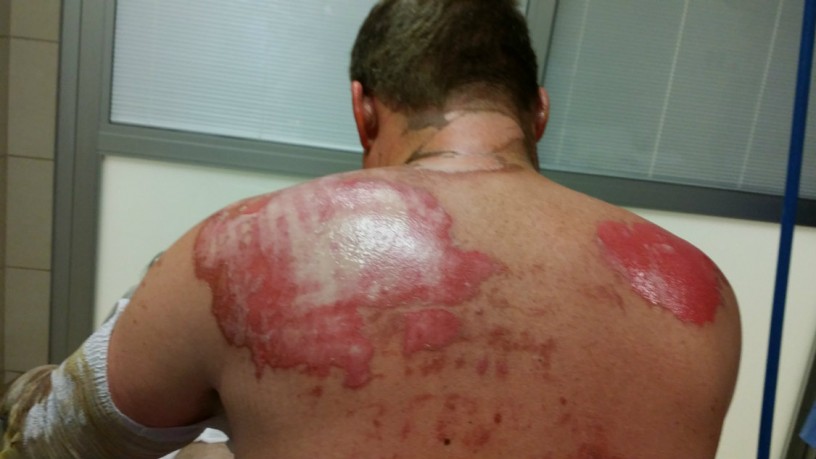Regulators launch inquiry after WFAA questions gas records by Brett Shipp, October 2, 2015, WFAA
 Some of Cody Murray’s injuries
Some of Cody Murray’s injuries
News 8 Investigates
PERRIN, Texas – Questions raised by News 8 about whether gas wells were properly constructed near a family home whose water well exploded last year have prompted an official review by the Texas Railroad Commission.
The investigation centers on whether gas drillers properly cemented wells to protect underground drinking water from Barnett Shale gas near the town of Perrin, located near the border of Jack and Palo Pinto counties.
Last month, WFAA reported on how Cody Murray and his family were nearly killed in August 2014 when a high-pressure fireball erupted from their water well’s pump house.
Their water well had been contaminated with methane, and tests by the family’s experts show the gas matches chemical properties of Barnett Shale gas, according to a lawsuit the family has filed.
EOG Resources, the defendant and owner of the gas wells near the family home, has denied any allegations of wrongdoing in legal filings.
While examining drilling records, News 8 discovered conflicting information and some evidence that gas wells near the explosion site may have been improperly built.
State records indicate that two gas wells, the Singleton 1-H and 2-H — which are about 1,000 feet from the Murray’s rural home — may have been improperly constructed.
To protect groundwater, state rules require that gas operators must inject cement around a steel pipe, known as a “surface casing,” to seal the well as it travels through and below drinking water zones.
“Standard-industry practice is to set the surface casing up to 200 feet below the specified depth required by the Ground Water Advisory Unit of the Railroad Commission to provide adequate protection of drinking water formations,” said Michael Patman, director of operations for Woodland Resources LLC, an oil-and-gas drilling firm with offices in Fort Worth and Bogota, Colombia.
“Proper well design, drilling techniques, and cement together can establish appropriate zonal isolation to protect drinking water formations, which is especially important if there are shallow gas zones near,” said Patman, who has more than 30 years of experience in the energy industry, and is not connected to the Murray case.
“Again, during casing operations I cannot stress [enough] the importance of proper cementation of surface casing,” he added. “Remedial cementing to rectify poor primary surface casing cementation can cause other problems, such as back side communication or leakage due to a poor cementing job.”
So how deep is the usable water in the area the Murray home?
Records from the Texas Water Development Board show water wells within a few miles of their house are drilled down to depths of 680 feet, 710 feet, and 725 feet.
When EOG Resources needed water for gas drilling operations, it tapped into a water formation at 560 feet in that area, state water well records show.
But records on file with the Texas Railroad Commission, which regulates oil-and-gas activity in the state, show that EOG set the surface casing on the two gas wells near the Murray’s home at depths of 546 and 547 feet. [Encana frac’d through their surface casing at Rosebud, Alberta, right into the community’s drinking water aquifers, at 399 feet! Where are the regulators? Where is the government? Where is the Globe and Mail’s investigation? The Calgary Herald’s? ]
That is above, not below, some of the water formations in the area, records show.
“If these wells aren’t cased to appropriate depths, you get certainty that water will be contaminated,” said Chris Hamilton, attorney for the Murray family.
This past July – seven years after the two gas wells were drilled in 2008 and nearly one year after the water well explosion – EOG Resources filed a new document with the state.
An EOG employee amended the original casing records, changing the surface casing depth on well number 2-H from 546 feet to 1,008 feet. EOG also submitted cement receipts indicating a casing job to that depth.
Yet, News 8 discovered a well log on file with the state that offers electronic images of what’s actually underground. We showed that chart, known as a resistivity log, to Patman.
He says it’s clear to him where the bottom, or the surface casing “shoe,” is located on the 2-H well.
“The casing shoe is set right here at 558 feet,” he said.
When we asked EOG to comment on the well image and the conflicting records, company officials declined, saying they can’t talk about pending litigation, referring to the Murray family lawsuit.
“If official documents have been altered in a way that’s not true — sworn documents — that’s a big problem, and we need answers to that,” said Chris Hamilton, the Murray family lawyer.
Records for 1-H well are also in conflict.
Cement records on file with the RRC show it the well was cased, or cemented, down to 547 feet. Yet a “well chronology report” by EOG, also on file with the state and apparently issued within days after the well was drilled in 2008, shows a casing depth of 999 feet.
Hamilton says the conflicts need to be investigated, the wells possibly shut down, and families like the Murrays better protected.
“When you see these types of discrepancies […] what that tells me is that’s a time bomb waiting to go off again,” Hamilton said. [Like Alberta Environment’s secretly editing (including changing the final conclusions) of the Alberta Research Council’s “independent” reviews of Alberta water contamination cases also with dangerous explosive levels of methane with fingerprints matching the oil and gas industry’s?]
The Texas Railroad Commission has scheduled a file review for the week of Oct. 12 to address EOG’s response to the discrepancies in the well records. [Emphasis added]
[Refer also to:
Cody Murray left permanently disabled from burns after fracking causes water well to explode
